| Citation: |
Zuolin Zhang, Mengjia Li, Jie Sun, Cong Chen, Jiangzhao Chen, Liming Ding. Dimethylammonium cation stabilizes all-inorganic perovskite solar cells[J]. Journal of Semiconductors, 2023, 44(3): 030202. doi: 10.1088/1674-4926/44/3/030202
****
Z L Zhang, M J Li, J Sun, C Chen, J Z Chen, L M Ding. Dimethylammonium cation stabilizes all-inorganic perovskite solar cells[J]. J. Semicond, 2023, 44(3): 030202. doi: 10.1088/1674-4926/44/3/030202
|
Dimethylammonium cation stabilizes all-inorganic perovskite solar cells
DOI: 10.1088/1674-4926/44/3/030202
More Information
-
References
[1] Yu G, Jiang K J, Gu W M, et al. Vacuum-assisted thermal annealing of CsPbI3 for highly stable and efficient inorganic perovskite solar cells. Angew Chem Int Ed, 2022, 61, e202203778 doi: 10.1002/anie.202203778[2] Wang H, Liu H, Dong Z, et al. Composition manipulation boosts the efficiency of carbon-based CsPbI3 perovskite solar cells to beyond 14%. Nano Energy, 2021, 84, 105881 doi: 10.1016/j.nanoen.2021.105881[3] Jia X, Zuo C, Tao S, et al. CsPb(IxBr1–x)3 solar cells. Sci Bull, 2019, 64, 1532 doi: 10.1016/j.scib.2019.08.017[4] Wang Y, Zhang X, Shi Z, et al. Stabilizing α-phase FAPbI3 solar cells. J Semicond, 2022, 43, 040202 doi: 10.1088/1674-4926/43/4/040202[5] Yuan Y, Yan G, Hong R, et al. Quantifying efficiency limitations in all-inorganic halide perovskite solar cells. Adv Mater, 2022, 34, e2108132 doi: 10.1002/adma.202108132[6] Li Z, Zhou F, Wang Q, et al. Approaches for thermodynamically stabilized CsPbI3 solar cells. Nano Energy, 2020, 71, 104634 doi: 10.1016/j.nanoen.2020.104634[7] Tian T, Yang M, Yang J, et al. Stabilizing black-phase CsPbI3 under over 70% humidity. J Semicond, 2022, 43, 030501 doi: 10.1088/1674-4926/43/3/030501[8] Wang K, Li Z, Zhou F, et al. Ruddlesden-popper 2D component to stabilize γ-CsPbI3 perovskite phase for stable and efficient photovoltaics. Adv Energy Mater, 2019, 9, 1902529 doi: 10.1002/aenm.201902529[9] Tian J, Xue Q, Yao Q, et al. Inorganic Halide perovskite solar cells: progress and challenges. Adv Energy Mater, 2020, 10, 2000183 doi: 10.1002/aenm.202000183[10] Wang Q, Zheng X, Deng Y, et al. Stabilizing the α-phase of CsPbI3 perovskite by sulfobetaine zwitterions in one-step spin-coating films. Joule, 2017, 1, 371 doi: 10.1016/j.joule.2017.07.017[11] Sanehira E M, Marshall A R, Christians J A, et al. Enhanced mobility CsPbI3 quantum dot arrays for record-efficiency, high-voltage photovoltaic cells. Sci Adv, 2017, 3, eaao4204 doi: 10.1126/sciadv.aao4204[12] Swarnkar A, Marshall A R, Sanehira E M, et al. Quantum dot-induced phase stabilization of α-CsPbI3 perovskite for high-efficiency photovoltaics. Science, 2016, 354, 92 doi: 10.1126/science.aag2700[13] Bai F, Zhang J, Yuan Y, et al. A 0D/3D heterostructured all-inorganic halide perovskite solar cell with high performance and enhanced phase stability. Adv Mater, 2019, 31, 1904735 doi: 10.1002/adma.201904735[14] Li Z, Sun Y, Yao H, et al. Intermediates transformation for efficient perovskite solar cells. J Energy Chem, 2021, 52, 102 doi: 10.1016/j.jechem.2020.04.047[15] Eperon G E, Paternò G M, Sutton R J, et al. Inorganic caesium lead iodide perovskite solar cells. J Mater Chem A, 2015, 3, 19688 doi: 10.1039/C5TA06398A[16] Kim Y G, Kim T Y, Oh J H, et al. Cesium lead iodide solar cells controlled by annealing temperature. Phys Chem Chem Phys, 2017, 19, 6257 doi: 10.1039/C6CP08177K[17] Zhang T, Dar M I, Li G, et al. Bication lead iodide 2D perovskite component to stabilize inorganic α-CsPbI3 perovskite phase for high-efficiency solar cells. Sci Adv, 2017, 3, e1700841 doi: 10.1126/sciadv.1700841[18] Yoon S M, Min H, Kim J B, et al. Surface engineering of ambient-air-processed cesium lead triiodide layers for efficient solar cells. Joule, 2021, 5, 183 doi: 10.1016/j.joule.2020.11.020[19] Yu B, Shi J, Tan S, et al. Efficient (>20 %) and stable all-inorganic cesium lead triiodide solar cell enabled by thiocyanate molten salts. Angew Chem Int Ed, 2021, 60, 13436 doi: 10.1002/anie.202102466[20] Lu C, Li X, Guo X, et al. Efficient inverted CsPbI3 perovskite solar cells fabricated in common air. Chem Eng J, 2023, 452, 139495 doi: 10.1016/j.cej.2022.139495[21] Cui Y, Shi J, Meng F, et al. A versatile molten-salt induction strategy to achieve efficient CsPbI3 perovskite solar cells with a high open-circuit voltage >1.2 V. Adv Mater, 2022, 34, e2205028 doi: 10.1002/adma.202205028[22] Jiang Y, Yuan J, Ni Y, et al. Reduced-dimensional α-CsPbX3 perovskites for efficient and stable photovoltaics. Joule, 2018, 2, 1356 doi: 10.1016/j.joule.2018.05.004[23] Huang Q, Liu Y, Li F, et al. Advances in cesium lead iodide perovskite solar cells: processing science matters. Mater Today, 2021, 47, 156 doi: 10.1016/j.mattod.2021.01.014[24] Bian H, Wang H, Li Z, et al. Unveiling the effects of hydrolysis-derived DMAI/DMAPbIx intermediate compound on the performance of CsPbI3 solar cells. Adv Sci, 2020, 7, 1902868 doi: 10.1002/advs.201902868[25] Ke W, Spanopoulos I, Stoumpos C C, et al. Myths and reality of HPbI3 in halide perovskite solar cells. Nat Commun, 2018, 9, 4785 doi: 10.1038/s41467-018-07204-y[26] Lee M V, Raga S R, Kato Y, et al. Transamidation of dimethylformamide during alkylammonium lead triiodide film formation for perovskite solar cells. J Mater Res, 2016, 32, 45 doi: 10.1557/jmr.2016.272[27] Pei Y, Liu Y, Li F, et al. Unveiling property of hydrolysis-derived DMAPbI3 for perovskite devices: composition engineering, defect mitigation, and stability optimization. iScience, 2019, 15, 165 doi: 10.1016/j.isci.2019.04.024[28] Gu X, Xiang W, Tian Q, et al. Rational surface-defect control via designed passivation for high-efficiency inorganic perovskite solar cells. Angew Chem Int Ed, 2021, 60, 23164 doi: 10.1002/anie.202109724[29] Sun X, Shao Z, Rao Y, et al. A Low-Temperature Additive-involved leaching method for highly efficient inorganic perovskite solar cells. Adv Energy Mater, 2020, 11, 2002754 doi: 10.1002/aenm.202002754[30] Jariwala S, Kumar R E, Eperon G E, et al. Dimethylammonium addition to halide perovskite precursor increases vertical and lateral heterogeneity. ACS Energy Lett, 2022, 7, 204 doi: 10.1021/acsenergylett.1c02302[31] Jung M, Ji S G, Kim G, et al. Perovskite precursor solution chemistry: from fundamentals to photovoltaic applications. Chem Soc Rev, 2019, 48, 2011 doi: 10.1039/C8CS00656C[32] Wang Y, Dar M I, Ono L K, et al. Thermodynamically stabilized β-CsPbI3-based perovskite solar cells with efficiencies >18%. Science, 2019, 365, 591 doi: 10.1126/science.aav8680[33] Wang Y, Liu X, Zhang T, et al. The role of dimethylammonium iodide in CsPbI3 perovskite fabrication: additive or dopant. Angew Chem Int Ed, 2019, 58, 16691 doi: 10.1002/ange.201910800[34] Chen Y, Liu X, Zhao Y. Organic matrix assisted low-temperature crystallization of black phase inorganic perovskites. Angew Chem Int Ed, 2022, 134, e202110603 doi: 10.1002/ange.202110603[35] Sun X, Shao Z, Li Z, et al. Highly efficient CsPbI3/Cs1–xDMAxPbI3 bulk heterojunction perovskite solar cell. Joule, 2022, 6, 850 doi: 10.1016/j.joule.2022.02.004[36] Liu Y, Li F, Gong J, et al. Low-temperature removal of residual dimethylammonium via surface molecular oligomerization for CsPbI3 perovskite solar cells. ACS Energy Lett, 2022, 7, 3227 doi: 10.1021/acsenergylett.2c01580[37] Meng F, Yu B, Zhang Q, et al. Ge incorporation to stabilize efficient inorganic CsPbI3 perovskite solar cells. Adv Energy Mater, 2022, 12, 2103690 doi: 10.1002/aenm.202103690[38] Ding Y, Guo Q, Geng Y, et al. A low-cost hole transport layer enables CsPbI2Br single-junction and tandem perovskite solar cells with record efficiencies of 17.8 % and 21.4 %. Nano Today, 2022, 46, 101586 doi: 10.1016/j.nantod.2022.101586 -
Proportional views





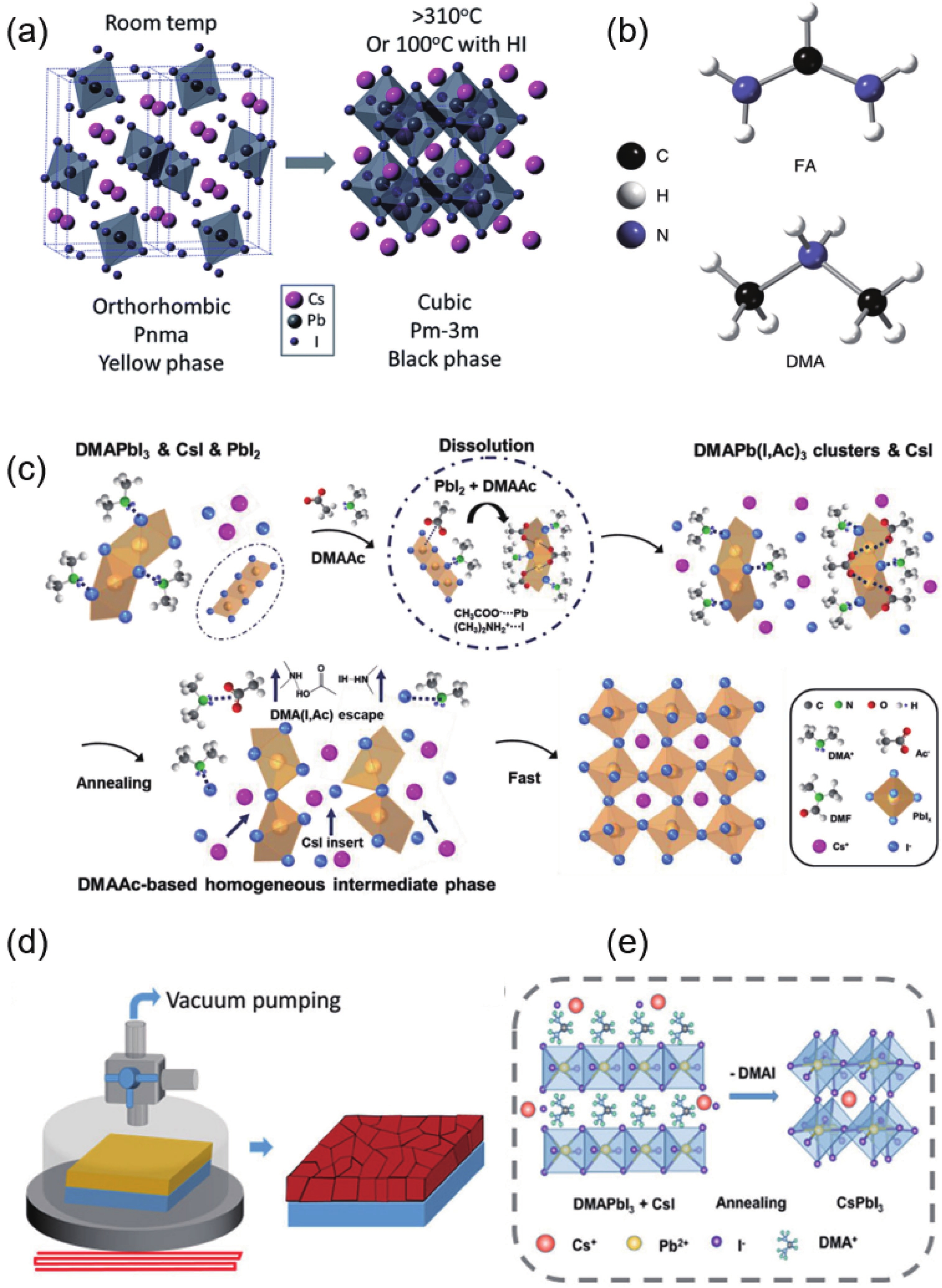
 DownLoad:
DownLoad:
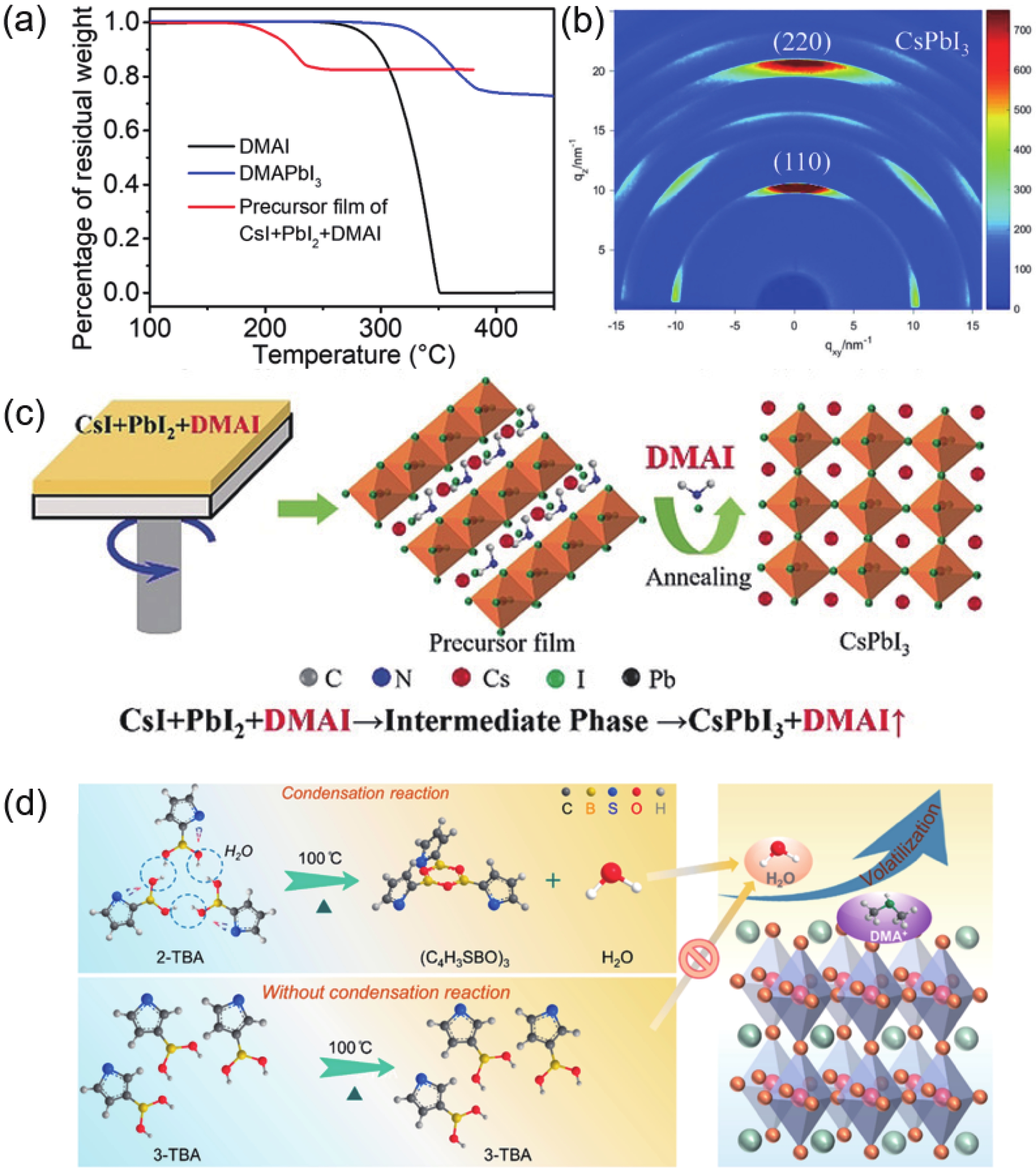










 Zuolin Zhang:received his BE from Hebei University of Technology in June 2021. Currently, he is a Master student in School of Materials Science and Engineering under the supervision of Prof. Cong Chen at Hebei University of Technology. His research focuses on perovskite solar cells
Zuolin Zhang:received his BE from Hebei University of Technology in June 2021. Currently, he is a Master student in School of Materials Science and Engineering under the supervision of Prof. Cong Chen at Hebei University of Technology. His research focuses on perovskite solar cells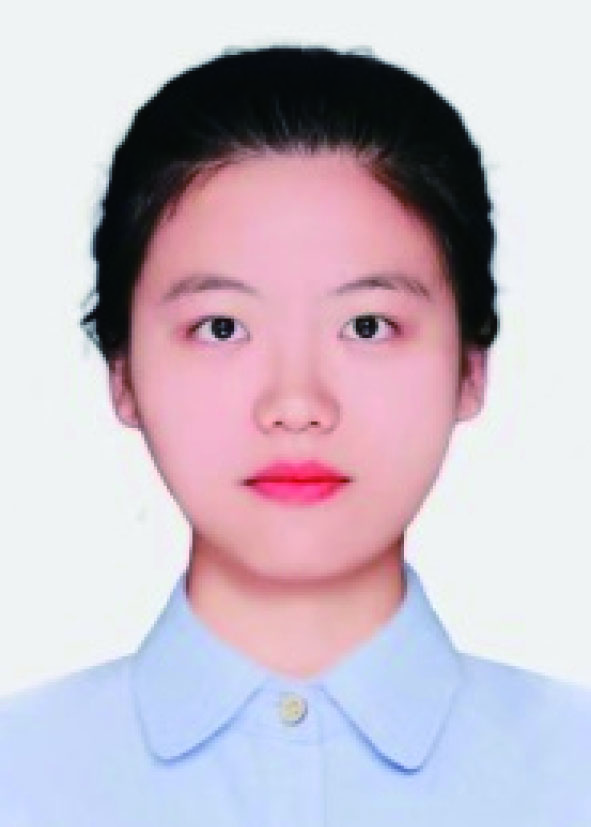 Mengjia Li:received her BE from Hebei University of Technology in June 2020. Currently, she is a PhD student in School of Materials Science and Engineering under the supervision of Prof. Cong Chen at Hebei University of Technology. Her research focuses on perovskite solar cells
Mengjia Li:received her BE from Hebei University of Technology in June 2020. Currently, she is a PhD student in School of Materials Science and Engineering under the supervision of Prof. Cong Chen at Hebei University of Technology. Her research focuses on perovskite solar cells Jie Sun:got her BS from Minzu University of China in 2021. Now she is a PhD student at University of Chinese Academy of Sciences under the supervision of Prof. Liming Ding. Her research focuses on perovskite devices
Jie Sun:got her BS from Minzu University of China in 2021. Now she is a PhD student at University of Chinese Academy of Sciences under the supervision of Prof. Liming Ding. Her research focuses on perovskite devices Cong Chen:is currently an associate professor at Hebei University of Technology. He received his PhD from Jilin University in June 2019. His research focuses on solar cells and NIR photodetectors
Cong Chen:is currently an associate professor at Hebei University of Technology. He received his PhD from Jilin University in June 2019. His research focuses on solar cells and NIR photodetectors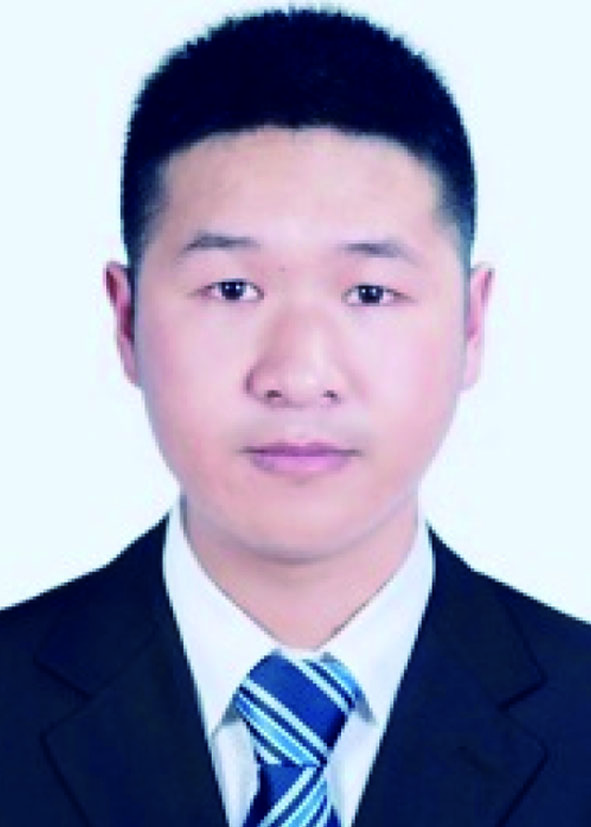 Jiangzhao Chen:is a professor at College of Optoelectronic Engineering in Chongqing University. He received PhD from Huazhong University of Science and Technology and worked as a postdoc at Sungkyunkwan University and at the University of Hong Kong, respectively. His work focuses on perovskite solar cells
Jiangzhao Chen:is a professor at College of Optoelectronic Engineering in Chongqing University. He received PhD from Huazhong University of Science and Technology and worked as a postdoc at Sungkyunkwan University and at the University of Hong Kong, respectively. His work focuses on perovskite solar cells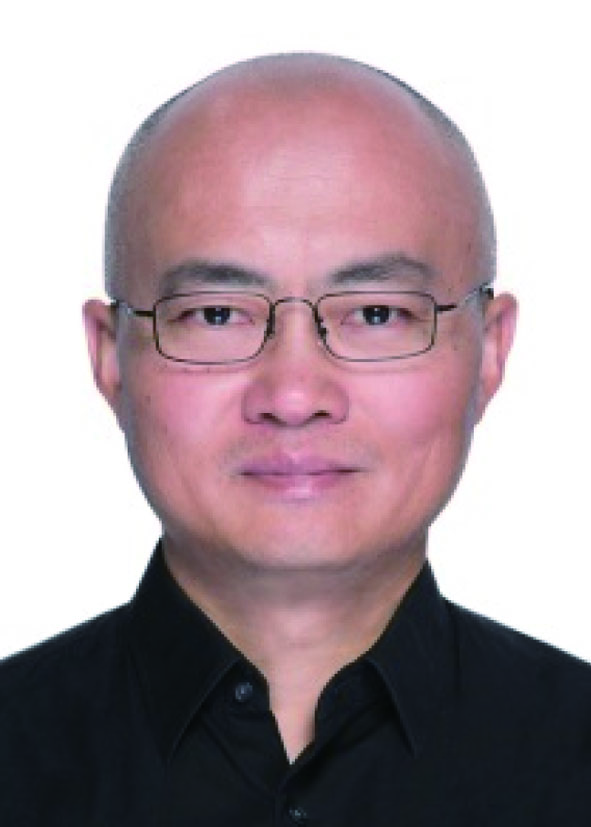 Liming Ding:got his PhD from University of Science and Technology of China (was a joint student at Changchun Institute of Applied Chemistry, CAS). He started his research on OSCs and PLEDs in Olle Inganäs Lab in 1998. Later on, he worked at National Center for Polymer Research, Wright-Patterson Air Force Base and Argonne National Lab (USA). He joined Konarka as a Senior Scientist in 2008. In 2010, he joined National Center for Nanoscience and Technology as a full professor. His research focuses on innovative materials and devices. He is RSC Fellow, and the Associate Editor for Journal of Semiconductors
Liming Ding:got his PhD from University of Science and Technology of China (was a joint student at Changchun Institute of Applied Chemistry, CAS). He started his research on OSCs and PLEDs in Olle Inganäs Lab in 1998. Later on, he worked at National Center for Polymer Research, Wright-Patterson Air Force Base and Argonne National Lab (USA). He joined Konarka as a Senior Scientist in 2008. In 2010, he joined National Center for Nanoscience and Technology as a full professor. His research focuses on innovative materials and devices. He is RSC Fellow, and the Associate Editor for Journal of Semiconductors



